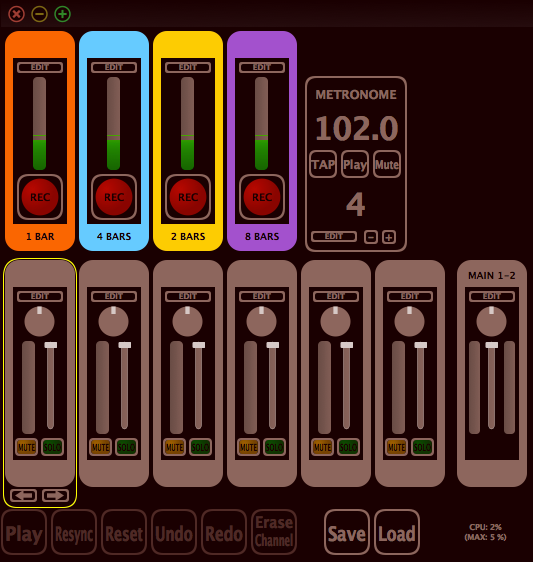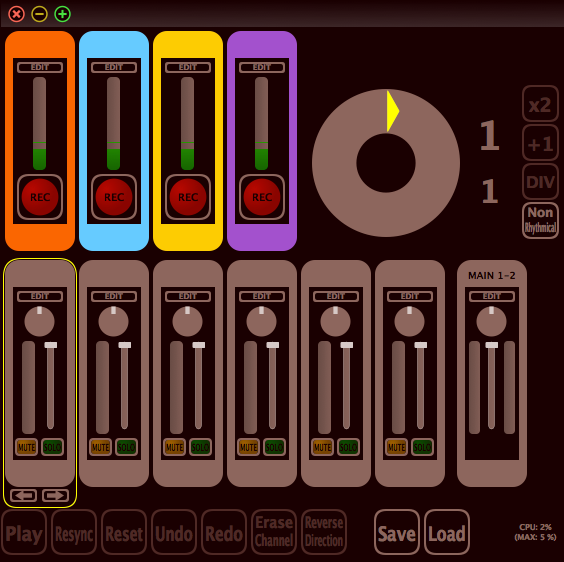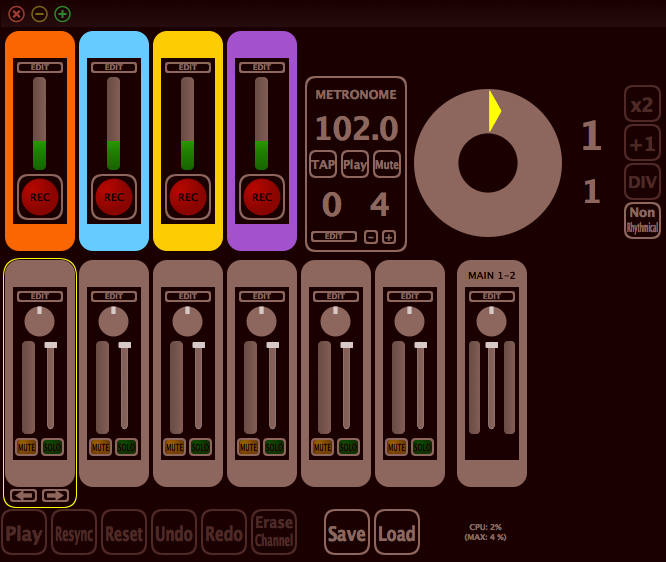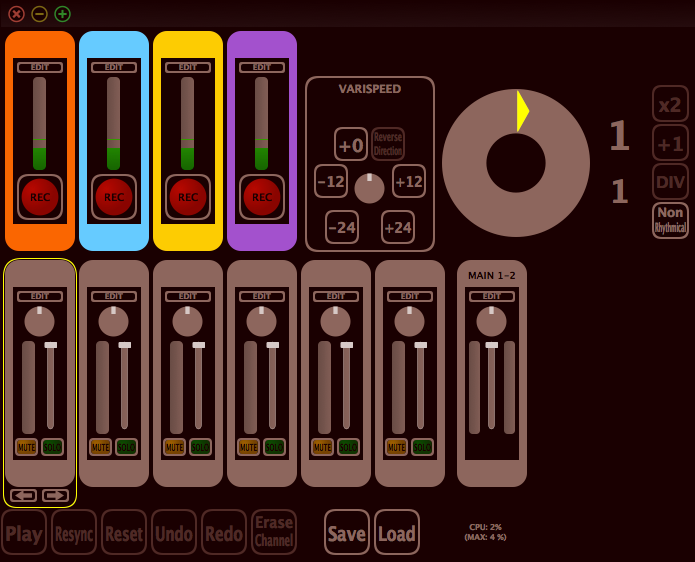Les modes rythmiques définissent comment les boucles vont être enregistrées et jouées.
Dans Repetito 3, il y a 4 modes rythmiques.
Si vous avez déjà utilisé un looper, vous serez sûrement familier avec l’un de ces modes.
Ouvrez la page du menu Settings/Session Settings pour choisir le mode rythmiques que vous souhaitez utiliser.
Mode rythmique durée prédéfinie (Predefined Durations)
Le mode rythmique durée prédéfinie (Predefined Durations) est un mode dans lequel on doit définir à l’avance la durée de bouclage pour chacune des pistes d’entrées (Input Channel).
Ce mode utilise le métronome de Repetito.
Par exemple, si vous souhaitez faire un rythme de beat-boxing qui tourne sur une mesure, il faut spécifier une durée de bouclage d’une mesure sur la piste d’entrée sur laquelle entre le micro voix.
Si vous souhaitez faire des boucles d’une autre durée de bouclage avec le même micro voix, par exemple pour un refrain, il faudra router ce micro vers une deuxième piste d’entrée (Input Channel) de Repetito.

En mode rythmique durée prédéfinie (Predefined Durations), le métronome est visible en haut à droite de l’interface.
Les durées prédéfinies sont visibles sur chaque piste d’entrée (Input Channel), et peuvent être éditées en cliquant dessus.
Les trois autres modes rythmiques sont des modes libres (Free Loops), pour lesquels la durée de bouclage est déterminée par la durée entre le Punch-In (le début de l’enregistrement) et le Punch-Out (la fin de l’enregistrement) de la première boucle.
Mode rythmique Free Loops
Le mode rythmique Free Loops est le mode rythmique par défaut parmi les modes libres.
Dans ce mode, la durée de la boucle principale – la première boucle rythmique à être enregistrée – va déterminer la durée de bouclage de toutes les boucles rythmiques que vous ajouterez ensuite.
Vous devez donc être très précis sur le moment où vous commencez à enregistrer et le moment où terminez d’enregistrer cette boucle, car ces deux moments décideront de la durée de bouclage pour toutes les autre boucles rythmiques.

En mode rythmique Free Loops, il y a un grand cercle avec un curseur de boucle à droite des input channels.
Le curseur de boucle indique la position de lecture de la boucle principale, qui est la première boucle que vous avez enregistré.
A droite du curseur, il y a des boutons qui affectent la durée de bouclage. Les commandes Multiply (multiplication) et Add (ajout) permettent d’enregistrer des boucles qui sont plus longues que la boucle principale. La commande Divide (divison) permet d’enregistrer des boucles qui ont une durée de bouclage plus courte que la boucle principale.
Le bouton Non Rhythmical permet d’enregistrer des boucles qui ne sont pas synchronisées avec la boucle principale, pour des sons de pad ou d’ambiance.
Mode rythmique Free Loops + Metronome
Le mode rythmique Free Loops + Metronome utilise le métronome.
Dans ce mode, vous spécifiez un tempo dans l’interface du métronome avant l’enregistrement de la boucle principale.
Une fois qu’un tempo a été défini, vous devez démarrer le métronome, pour que des messages MIDI de synchronisation (MIDI Beat Clock) et que le clic du métronome soit joué.
Lorsque vous enregistrez la boucle principale, Repetito cale le début et la fin de la boucle pour que la durée de bouclage soit exactement un nombre de temps musicaux (noires) du tempo spécifié et que la boucle soit synchronisée au tempo.
Lorsque vous appelez la commande Play/Stop pour arrêter le looper, le métronome va aussi automatiquement arrêter l’envoi des messages MIDI de synchronisation et le clic tempo.

En mode rythmique Free Loops + Metronome, l’interface montre le métronome ainsi que le curseur de boucle du mode Free Loops.
Mode rythmique Free Loops + Varispeed
Le mode rythmique Free Loops + Varispeed active le Session Varispeed, qui permet de modifier la vitesse et le sens de lecture de toutes les boucles ensemble.
Le Session Varispeed peut être pensé comme le changement de vitesse sur un magnétophone à bande ou cassette.
La vitesse de lecture peut être accélérée jusqu’à 4 fois plus vite (changement de hauteur de 2 octaves vers le haut) ou ralentie jusqu’à 4 fois plus lentement (changement de hauteur de 2 octaves vers le bas).
Le Session Varispeed a une interface dédiée avec un contrôleur rotatif et des bouton pour forcer des valeurs spécifiques de vitesse.
Ce mode rythmique est assez similaire au mode rythmique Free Loops : lorsque vous enregistrez la boucle principale, vous devez être très précis lors du début et la fin de l’enregistrement de la boucle principale, car ces deux moments déterminent la durée de bouclage.
Avec le Session Varispeed, vous pouvez ralentir les boucles et enregistrer une boucle à cette vitesse. Lorsque le varispeed sera de nouveau à sa vitesse normale, la boucle enregistrée sera jouée plus vite et sera donc plus aiguë.
Vous aurez un effet similaire si vous enregistrez une boucle avec un varispeed à une vitesse élevée, ou avec un sens de lecture inverse.

En mode rythmique Free Loops + Varispeed, le Session Varispeed apparait sur l’interface à gauche du curseur de boucle.




